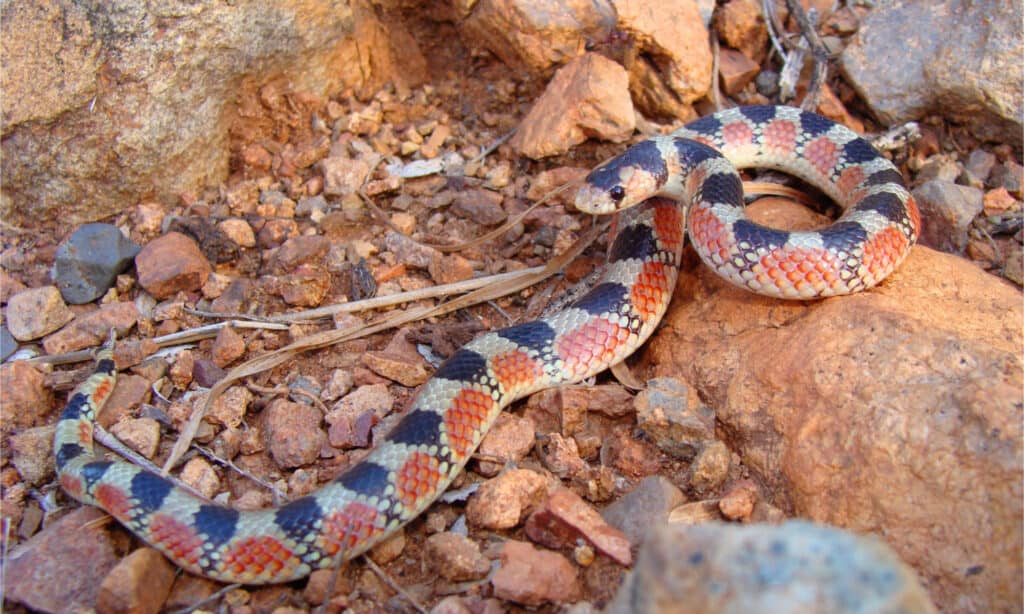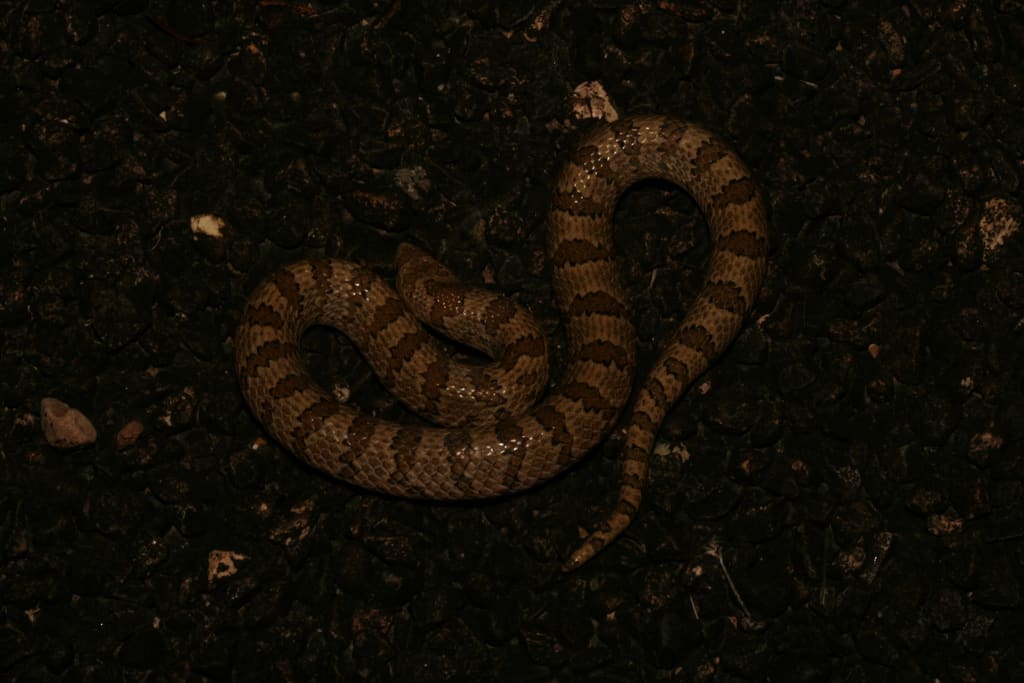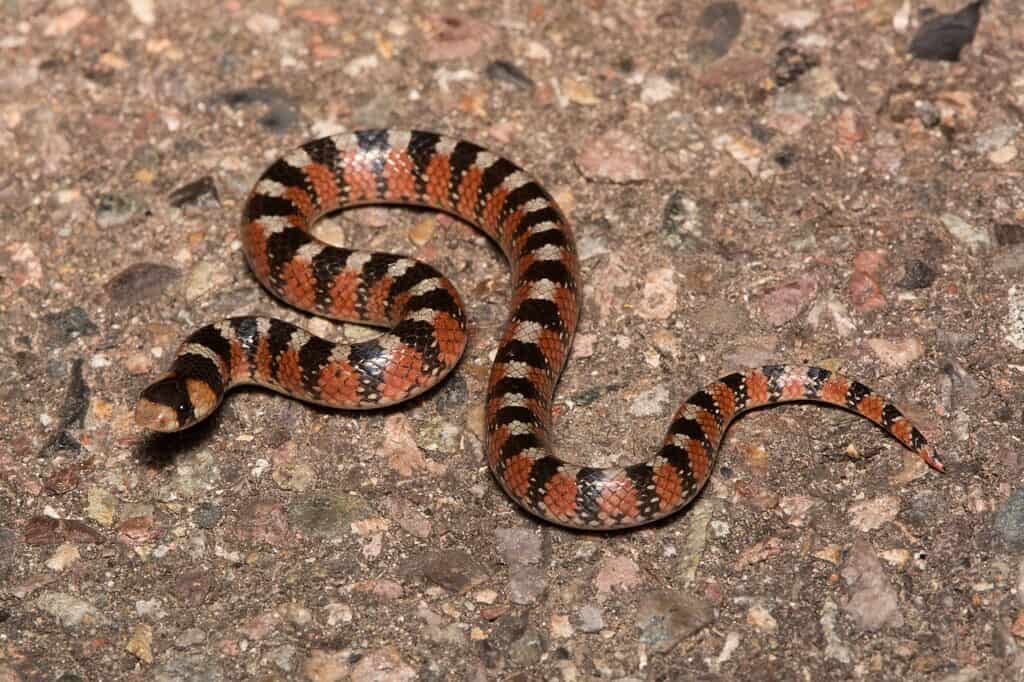Colubrid snakes comprise the largest family of snakes, with over 2000 species worldwide. Most colubrid are medium-sized and lack a pelvic girdle or vestigial hind limbs.
Hooknose snakes are small, nonvenomous colubrid snakes with a unique feature you can hardly miss if you look closely enough.
As the name implies, the hooknose snake has a typical slightly upturned or ‘hook-shaped’ snout, making it an excellent burrower in its preferred sandy habitats.
How big do hooknose snakes get despite being known for their small size?
Find out in this article:
About Hooknose Snakes

The hooknose snake has a typical slightly upturned or ‘hook-shaped’ snout.
©Matt Jeppson/Shutterstock.com
Hooknose snakes belong to the genus Gyalopion and are endemic to the southwestern United States and Mexico.
The following species and subspecies are recognized:
- Gyalopion canum – Western hook-nosed snake (occasionally referred to as the Chihuahuan hook-nosed snake because it is frequently found in the Chihuahuan Desert).
- Gyalopion quadrangulare – Desert hook-nosed snake. Has two subspecies; Gyalopion quadrangulare desertorum and Gyalopion quadrangulare quadrangulare.
What Do Hooknose Snakes Look Like?
The hooknose snake got its name from its characteristic sharp-edged upturned snout, which has a concave rostral scale, unlike hognose snakes with keeled rostral scales.
The dorsal color of hook-nosed snakes is normally light brown, pale tan, yellowish tan, reddish-brown, orange-tan, gray, or grayish-brown with a white, pale, or cream-colored underside.
They have a series of 25- 30 black or dark brown crossbands down their back, which may appear increasingly more pronounced on the head. In addition to this, hook-nosed snakes have round pupils and smooth dorsal scales.
What is the Largest Hooknose Snake Ever Found?
Hooknose snakes (Gyalopion species) rarely grow beyond 10 inches (25.5 cm) in total length (including tail). The Western hooknose snake is a small, stout snake, and an average adult individual grows to about 7-11 inches (18-28 cm) in total length. The maximum recorded length observed for this species is 15 inches (38.4 cm).
Where are Hooknose Snakes Found?

The hooknose snake species can be found in the United States and Mexico.
©francis crawley / Creative Commons – License
Hooknose snake species are found in the United States and Mexico. The western hooknose snake’s range in the United States extends across western Texas, southeast Arizona, and central and southern New Mexico.
In Mexico, they’re found in Coahuila, Chihuahua, Jalisco, Durango, Michoacán, Nayarit, San Luis Potosí, Zacatecas, Nuevo León, and Sonora. Desert hooknose snakes have a limited range, and they can be found from Arizona in the United States into Sinaloa and Sonora in Mexico.
Hooknose snakes prefer slightly sandy or shortgrass prairie habitats. Typically recognized as nocturnal and secretive snakes, they spend most of their time underground, hiding in burrows, under rocks, grassy foothills, or buried in the soil.
With blunt rostrum, hooknose snakes are skilled burrowers, and their burrowing habit makes them a difficult species to encounter, using surface rocks and loose soils for cover. Most human sightings of this species occur on cloudy days or after rain.
What Do Hooknose Snakes Eat?

Hooknose snakes include spiders and centipedes in their diet.
©Andrew DuBois / CC BY-SA 4.0 – License
The main diet of hook-nosed snakes consists of spiders and centipedes, but they also eat reptile eggs, insects, scorpions, lizards, and other small snakes. The hooknose snake uses its characteristic upturned snout, called ‘hooked nose,’ to forage through debris on the forest floor for food.
Lifespan: How Long Do Hooknose Snakes Live?
The lifespan of the average wild hooknose snake is around 9 to 19 years in the wild and 15 to 20 years in captivity. Hooknose snakes are prey for many predators such as hawks, crows, fox, and even larger snakes. Not only are these snakes prey animals, but they are also collected for pet trade.
Are Hooknose Snakes Dangerous?
The hooknose snake is a harmless non-venomous snake, and this species poses no threat to human or pet life because they have not been known to bite. The hooknose snake’s resemblance to the venomous coral snake frightens it away from predators who often mistake it for the dangerous snake.
One of the unique defensive behaviors of the hooknose snake, when threatened, is to make a popping noise or farting sound with its cloaca. Discover Magazine reports how a morphologist, Bruce Young, studied this unusual behavior and observed that some individuals farted with so much energy that they lifted themselves off the ground –flying!
Hooknose snakes are likely to coil up and display closed mouths striking when scared or threatened. Another unique anti-predator behavior is whipping their tails around when touched and smearing musk on a predator.
Conservation Status of the Hooknose Snake
The hooknose snake is classified as Least Concern in the IUCN listing category. Its population is relatively stable across its range, so this species does not qualify for a more at-risk category.
Other Record-Breaking Snakes

The Titanoboa is believed to be the largest snake to ever live.
©Daniel Eskridge/Shutterstock.com
Titanoboa, the largest snake ever discovered, lived 60 million years ago. Fossils of this gigantic creature, measuring 42 feet long and weighing 2,500 pounds, were found in Colombia. It is believed to have been an apex predator and behaved much like a giant anaconda, living mostly in the water. It could have easily consumed fish, 12-foot crocodiles, and turtles 5 feet in diameter. Some scientists have argued that its size indicates a tropical climate warmer than previously thought, as no cold-blooded animal that size could regulate their body temperature in cooler weather.
It lived approximately during the Paleocene epoch and was discovered in the Cerrejon coal mine of Columbia. Its size would have made it an apex predator of its time, with some scientists believing it to be capable of taking down large dinosaurs. Unlike modern snakes, this giant serpent had four legs that were likely used for support when moving around or climbing trees.
The photo featured at the top of this post is © Andrew DuBois / CC BY-SA 4.0 – License / Original
Discover the "Monster" Snake 5X Bigger than an Anaconda
Every day A-Z Animals sends out some of the most incredible facts in the world from our free newsletter. Want to discover the 10 most beautiful snakes in the world, a "snake island" where you're never more than 3 feet from danger, or a "monster" snake 5X larger than an anaconda? Then sign up right now and you'll start receiving our daily newsletter absolutely free.
Thank you for reading! Have some feedback for us? Contact the AZ Animals editorial team.






